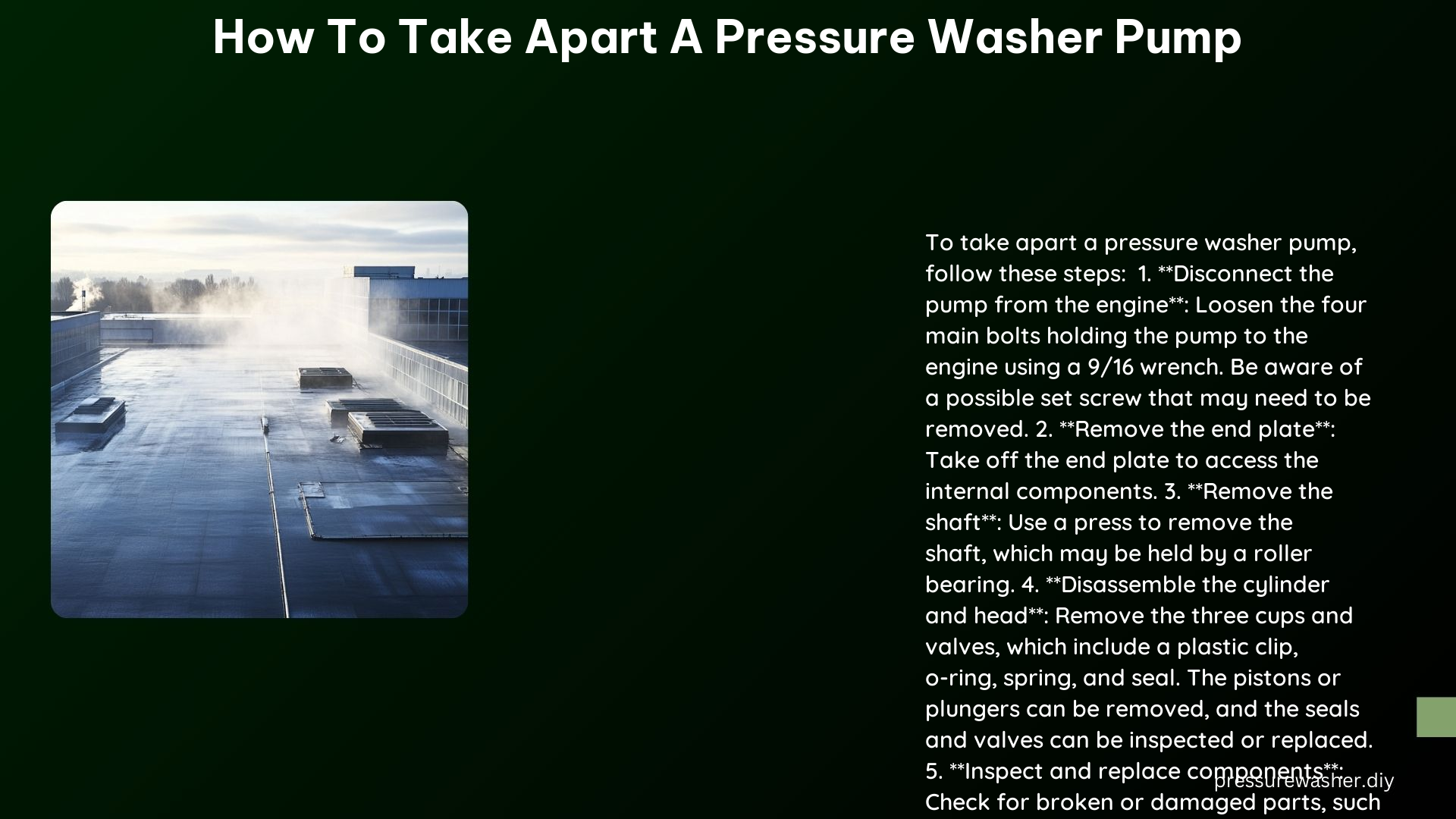Taking apart a pressure washer pump can be a daunting task, but with the right tools and knowledge, it can be a straightforward process. In this comprehensive guide, we’ll walk you through the step-by-step process of disassembling a pressure washer pump, covering everything from the necessary tools to the technical specifications of the various pump components.
Tools Required
To take apart a pressure washer pump, you’ll need the following tools:
- 9/16 wrench
- 8 millimeter allen key
- Anti-seize lubricant
- Torque wrench (for reassembly)
- Rubber mallet (for removing stubborn parts)
- Cleaning solvent and rags
Steps to Disassemble a Pressure Washer Pump

-
Loosen the Four Main Bolts: Using a 9/16 wrench, loosen the four bolts that hold the pump to the engine. Do not remove them yet, just loosen them.
-
Check for a Set Screw: Some pressure washer pumps have an additional set screw that may not be immediately visible. Turn the pump to the side and look for a set screw inside a hole. Use an 8 millimeter allen key to remove it if present.
-
Remove the Four Main Bolts: Once the set screw is removed (if present), completely remove the four main bolts using the 9/16 wrench.
-
Remove the Pump: Carefully lift the pump off the engine, taking note of any additional hardware or seals that need to be removed or replaced.
-
Disassemble the Pump: For a detailed teardown, refer to the specific pump model’s manual or online guides. Typically, this involves removing end plates, shafts, and internal components like valves, pistons, and seals.
-
Valves: Pressure washer pumps typically have inlet and outlet valves that control the flow of water. These valves may need to be inspected and replaced if worn or damaged.
- Pistons: The pistons are responsible for creating the high-pressure water flow. Inspect the pistons for wear and replace them if necessary.
- Seals: Pressure washer pumps have various seals, including piston seals, shaft seals, and O-rings. These seals may need to be replaced during the disassembly process.
-
Bearings: The pump’s bearings should be inspected for wear and replaced if necessary. Proper lubrication is crucial for the bearings’ longevity.
-
Clean and Inspect Components: Thoroughly clean all the disassembled components using a cleaning solvent and rags. Inspect each part for wear, damage, or corrosion, and replace any parts that are beyond repair.
-
Reassemble the Pump: Carefully reassemble the pump, following the manufacturer’s instructions or the disassembly process in reverse. Apply anti-seize lubricant to the threads of the bolts and any other moving parts to prevent future seizure.
-
Torque the Bolts: Use a torque wrench to tighten the four main bolts to the manufacturer’s specified torque value, typically between 30-50 ft-lbs.
Preventing Fluid Drainage
When disassembling a pressure washer pump, it’s important to take steps to prevent fluid drainage and spills:
- Drain the Pump: Before disassembling the pump, drain any remaining fluid to minimize the mess and potential for spills.
- Use Plugs or Caps: If the pump has open ports, use plugs or caps to prevent fluid from draining out during the disassembly process.
Removing a Seized or Rusted Pump
If the pressure washer pump is seized or heavily rusted, you may need to take additional steps to loosen the components:
- Apply Penetrating Oil: Apply a penetrating oil like WD-40 or Liquid Wrench to the bolts and any seized parts to help loosen them.
- Use Heat: Apply heat to the seized parts using a hair dryer or heat gun to help expand the metal and loosen the parts.
- Use a Breaker Bar: If the parts are severely rusted, use a breaker bar to apply extra torque without damaging the surrounding components.
Technical Specifications
Pump Types
Pressure washer pumps can be driven by various power sources, including:
- Electric motors
- Gasoline engines
- Diesel engines
The most common types of pressure washer pumps are:
- Triplex plunger pumps
- Vertical axial cam pumps
Pump Components
The main components of a pressure washer pump include:
- Pistons
- Valves
- Seals
- Bearings
- Shafts
Disassembly Considerations
When disassembling a pressure washer pump, it’s important to:
- Be prepared to handle oil spills and take necessary safety precautions.
- Refer to the specific pump model’s manual or online guides for detailed disassembly instructions.
- Use the appropriate tools and follow the manufacturer’s recommended torque values during reassembly.
